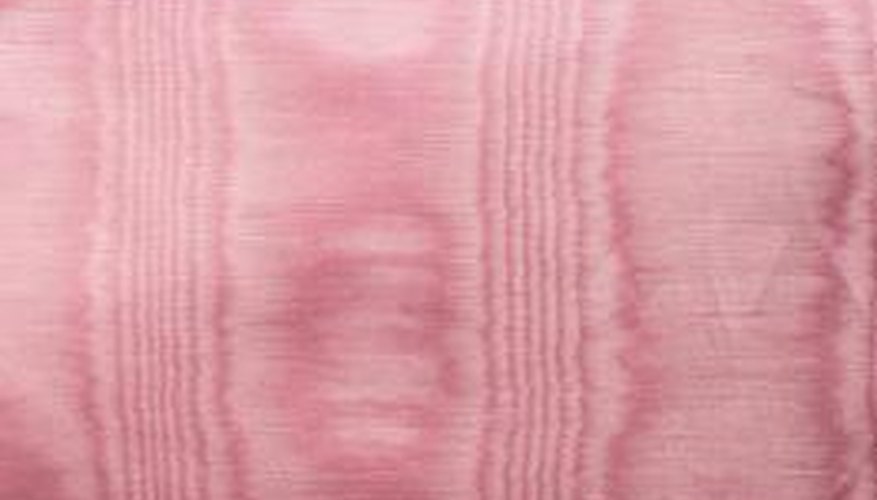Moire is a type of pattern that is produced by pressing fabric against hotplates engraved with a design, and is most commonly made from taffeta, which is a very stiff and closely-woven type of fabric. Taffeta was originally made from silk, but modern taffeta is also made from cotton, nylon, acrylic and polyester. Many types of moire taffeta are dyeable, and you can dye taffeta yourself, but you need to know what type of material the taffeta is made from for best results.
- Moire is a type of pattern that is produced by pressing fabric against hotplates engraved with a design, and is most commonly made from taffeta, which is a very stiff and closely-woven type of fabric.
- Many types of moire taffeta are dyeable, and you can dye taffeta yourself, but you need to know what type of material the taffeta is made from for best results.
Determine what your moire taffeta is made from. This is listed on the bolt when you purchase the fabric or on the tag of a garment. If the fabric is made from silk or nylon, it can be dyed with an acid dye. If it is cotton, it can be dyed with a fibre-reactive dye. If it is made from acrylic or polyester, it will be difficult to dye and you may not get good results. You cannot dye anything that is dry-clean only.
Wash the fabric if it is dyeable.
Add some water to the dye powder, mixing it until you have a paste, then add some warm water so that you have a cup of liquid dye. The amount required will depend on how much fabric you are dyeing and the brand of dye. If you have trouble dissolving the dye well, add a small amount of urea. If you are using fibre-reactive dye, mix some noniodized salt in lukewarm water as well.
- Wash the fabric if it is dyeable.
- If you have trouble dissolving the dye well, add a small amount of urea.
Fill a washing machine with water. For acid dyes, this water must be very hot. You can add some boiling water to the tub to make the water even hotter.
Pour dye and saltwater into the washing machine, setting it to agitate until the dye is thoroughly mixed. Then add the moire taffeta, continuing to let the washing machine agitate.
Wait a few minutes. If you are using acid dye, add vinegar to the washing machine. The vinegar is the acid in acid dye. If you are using fibre-reactive dye, dissolve some soda ash in water and add it to the washing machine, adding a small amount at a time over a period of fifteen minutes. Do not pour either vinegar or soda ash onto the fabric; pour into the water instead.
- Pour dye and saltwater into the washing machine, setting it to agitate until the dye is thoroughly mixed.
- If you are using acid dye, add vinegar to the washing machine.
Allow the washing machine to cycle through.You will probably need to let the fabric run through two or three cycles. Do not let the machine run completely through the cycle and drain the water. Set back the cycle when it is reaching the end instead, or you will have to make a new batch of dye. The longer the item sits in the dye, the deeper the colour becomes.
Allow the washing machine to complete the cycle, draining the tub. Wash the fabric in plain water at least once before removing the fabric.
TIP
A washing machine is convenient for dying a large amount of fabric or a large item because it does not require stirring or cleanup after dying. However, if you are dying something small, you can follow the same steps using a bucket or large pot. Read the instructions on the dye that you are using. Different dye brands have different requirements. This will also help you to determine the best quantity of dye to use, as well as the right amount of other ingredients, such as vinegar. Gloves will protect your hands from dye and caustic chemicals.
